【Android开发学习笔记之一】5大布局方式详解
Android中常用的5大布局方式有以下几种:
- 线性布局(LinearLayout):按照垂直或者水平方向布局的组件。
- 帧布局(FrameLayout):组件从屏幕左上方布局组件。
- 表格布局(TableLayout):按照行列方式布局组件。
- 相对布局(RelativeLayout):相对其它组件的布局方式。
- 绝对布局(AbsoluteLayout):按照绝对坐标来布局组件。
1. 线性布局
线性布局是Android开发中最常见的一种布局方式,它是按照垂直或者水平方向来布局,通过“android:orientation”属性可以设置线性布局的方向。属性值有垂直(vertical)和水平(horizontal)两种。
常用的属性:
android:orientation:可以设置布局的方向
android:gravity:用来控制组件的对齐方式
layout_weight:控制各个组件在布局中的相对大小
第一个实例
①效果图:
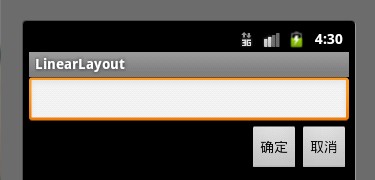
②核心代码如下:
main.xml
<?xml version="1.0" encoding="utf-8"?>
<LinearLayout xmlns:android="http://schemas.android.com/apk/res/android"
android:orientation="vertical"
android:layout_width="fill_parent"
android:layout_height="fill_parent"
>
<LinearLayout
android:layout_width="fill_parent"
android:layout_height="wrap_content"
android:orientation="vertical"
>
<EditText
android:layout_width="fill_parent"
android:layout_height="wrap_content"
/>
</LinearLayout>
<LinearLayout
android:layout_width="fill_parent"
android:layout_height="wrap_content"
android:orientation="horizontal"
android:gravity="right"
>
<!-- android:gravity="right"表示Button组件向右对齐 -->
<Button
android:layout_height="wrap_content"
android:layout_width="wrap_content"
android:text="确定"
/>
<Button
android:layout_height="wrap_content"
android:layout_width="wrap_content"
android:text="取消"
/>
</LinearLayout>
</LinearLayout>
第二个实例
①效果图:
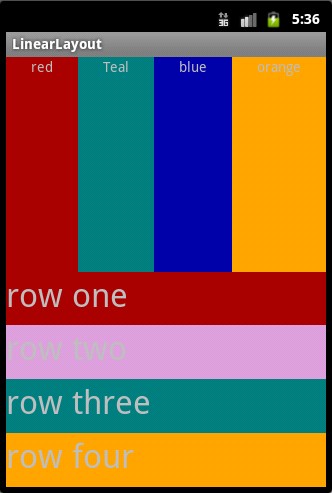
②核心代码:
<?xml version="1.0" encoding="utf-8"?>
<LinearLayout xmlns:android="http://schemas.android.com/apk/res/android"
android:orientation="vertical" android:layout_width="fill_parent"
android:layout_height="fill_parent"> <LinearLayout
android:orientation="horizontal"
android:layout_width="fill_parent"
android:layout_height="fill_parent"
android:layout_weight="1"> <TextView
android:text="red"
android:gravity="center_horizontal"
android:background="#aa0000"
android:layout_width="wrap_content"
android:layout_height="fill_parent"
android:layout_weight="1"
/>
<!--android:gravity="center_horizontal"水平居中 -->
<!--layout_weight属性以控制各个控件在布局中的相对大小。layout_weight属性是一个非负整数值。
线性布局会根据该控件layout_weight值与其所处布局中所有控件layout_weight值之和的比值为该控件分配占用的区域。
例如,在水平布局的LinearLayout中有两个Button,这两个Button的layout_weight属性值都为1,
那么这两个按钮都会被拉伸到整个屏幕宽度的一半。如果layout_weight指为0,控件会按原大小显示,不会被拉伸;
对于其余layout_weight属性值大于0的控件,系统将会减去layout_weight属性值为0的控件的宽度或者高度,
再用剩余的宽度或高度按相应的比例来分配每一个控件显示的宽度或高度-->
<TextView
android:text="Teal"
android:gravity="center_horizontal"
android:background="#008080"
android:layout_width="wrap_content"
android:layout_height="fill_parent"
android:layout_weight="1"/> <TextView
android:text="blue"
android:gravity="center_horizontal"
android:background="#0000aa"
android:layout_width="wrap_content"
android:layout_height="fill_parent"
android:layout_weight="1"
/> <TextView
android:text="orange"
android:gravity="center_horizontal"
android:background="#FFA500"
android:layout_width="wrap_content"
android:layout_height="fill_parent"
android:layout_weight="1"
/> </LinearLayout>
<LinearLayout
android:orientation="vertical"
android:layout_width="fill_parent"
android:layout_height="fill_parent"
android:layout_weight="1"> <TextView
android:text="row one"
android:textSize="15pt"
android:background="#aa0000"
android:layout_width="fill_parent"
android:layout_height="wrap_content"
android:layout_weight="1"
/>
<!-- -->
<TextView
android:text="row two"
android:textSize="15pt"
android:background="#DDA0DD"
android:layout_width="fill_parent"
android:layout_height="wrap_content"
android:layout_weight="1"
/> <TextView
android:text="row three"
android:textSize="15pt"
android:background="#008080"
android:layout_width="fill_parent"
android:layout_height="wrap_content"
android:layout_weight="1"
/>
<TextView
android:text="row four"
android:textSize="15pt"
android:background="#FFA500"
android:layout_width="fill_parent"
android:layout_height="wrap_content"
android:layout_weight="1"
/>
</LinearLayout>
</LinearLayout>
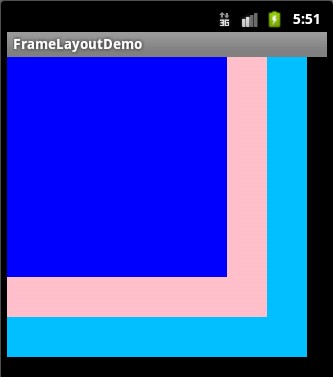
<?xml version="1.0" encoding="utf-8"?>
<FrameLayout xmlns:android="http://schemas.android.com/apk/res/android"
android:layout_width="fill_parent"
android:layout_height="fill_parent"
>
<TextView
android:layout_width="300dp"
android:layout_height="300dp"
android:background="#00BFFF"
/>
<TextView
android:layout_width="260dp"
android:layout_height="260dp"
android:background="#FFC0CB"
/>
<TextView
android:layout_width="220dp"
android:layout_height="220dp"
android:background="#0000FF"
/>
</FrameLayout>
android:shrinkColumns:收缩指定的列以适合屏幕,不会挤出屏幕
android:stretchColumns:尽量把指定的列填充空白部分
android:layout_column:控件放在指定的列
android:layout_span:该控件所跨越的列数
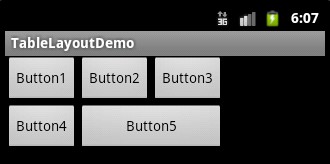
<?xml version="1.0" encoding="utf-8"?>
<TableLayout xmlns:android="http://schemas.android.com/apk/res/android"
android:layout_width="fill_parent"
android:layout_height="fill_parent"
>
<TableRow>
<Button
android:text="Button1"
/>
<Button
android:text="Button2"
/>
<Button
android:text="Button3"
/>
</TableRow>
<TableRow>
<Button
android:text="Button4"
/>
<Button
android:layout_span="2"
android:text="Button5"
/>
</TableRow> </TableLayout>
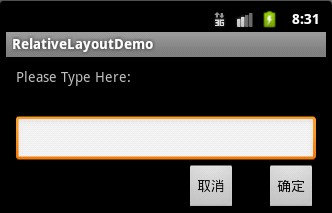
<?xml version="1.0" encoding="utf-8"?>
<RelativeLayout xmlns:android="http://schemas.android.com/apk/res/android"
android:layout_width="fill_parent"
android:layout_height="wrap_content"
android:padding="10px"
>
<TextView
android:id="@+id/tev1"
android:layout_width="wrap_content"
android:layout_height="wrap_content"
android:layout_marginBottom="30dp"
android:text="Please Type Here:"
/>
<EditText
android:id="@+id/tx1"
android:layout_width="match_parent"
android:layout_height="wrap_content"
android:layout_below="@id/tev1"
/>
<Button
android:id="@+id/btn1"
android:layout_height="wrap_content"
android:layout_width="wrap_content"
android:layout_below="@id/tx1"
android:layout_alignParentRight="true"
android:text="确定"
/>
<Button
android:id="@+id/btn2"
android:layout_height="wrap_content"
android:layout_width="wrap_content"
android:layout_below="@id/tx1"
android:layout_toLeftOf="@id/btn1"
android:layout_marginRight="30dp"
android:text="取消"
/>
</RelativeLayout>
【Android开发学习笔记之一】5大布局方式详解的更多相关文章
- 【转】Android开发学习笔记:5大布局方式详解
Android中常用的5大布局方式有以下几种: 线性布局(LinearLayout):按照垂直或者水平方向布局的组件. 帧布局(FrameLayout):组件从屏幕左上方布局组件. 表格布局(Tabl ...
- Android开发5大布局方式详解
Android中常用的5大布局方式有以下几种: 线性布局(LinearLayout):按照垂直或者水平方向布局的组件. 帧布局(FrameLayout):组件从屏幕左上方布局组件. 表格布局(Tabl ...
- Android开发之5大布局方式详解
Android中常用的5大布局方式有以下几种: 线性布局(LinearLayout):按照垂直或者水平方向布局的组件. 帧布局(FrameLayout):组件从屏幕左上方布局组件. 表格布局(Tabl ...
- android开发学习笔记000
使用书籍:<疯狂android讲义>——李刚著,2011年7月出版 虽然现在已2014,可我挑来跳去,还是以这本书开始我的android之旅吧. “疯狂源自梦想,技术成就辉煌.” 让我这个 ...
- Linux防火墙iptables学习笔记(三)iptables命令详解和举例[转载]
Linux防火墙iptables学习笔记(三)iptables命令详解和举例 2008-10-16 23:45:46 转载 网上看到这个配置讲解得还比较易懂,就转过来了,大家一起看下,希望对您工作能 ...
- (转)live555学习笔记10-h264 RTP传输详解(2)
参考: 1,live555学习笔记10-h264 RTP传输详解(2) http://blog.csdn.net/niu_gao/article/details/6936108 2,H264 sps ...
- 【Android开发学习笔记】【第八课】五大布局-下
概念 五大布局上一篇文章已经介绍了 LinearLayout RelativeLayout 这一篇我们介绍剩下的三种布局 FrameLayout 五种布局中最佳单的一种布局.在这个布局在整个界面被当成 ...
- 【Android开发学习笔记】【第七课】五大布局-上
概念 Android程序各式各样,依靠的就是布局,先来看看布局都是怎么来的: 白色部分就是我们经常用的几种布局,主要说说介绍下面五大布局 FrameLayout AbsoluteLayout Line ...
- 【转】Android开发学习笔记(一)——初识Android
对于一名程序员来说,“自顶向下”虽然是一种最普通不过的分析问题和解决问题的方式,但其却是简单且较为有效的一种.所以,将其应用到Android的学习中来,不至于将自己的冲动演变为一种盲目和不知所措. 根 ...
随机推荐
- 干了这杯Java之Vector
Vector实现了AbstractList抽象类和List接口,和ArrayList一样是基于Array存储的 Vector 是线程安全的,在大多数方法上存在synchronized关键字 //Vec ...
- ZendStudio-12.5.0-win32.win32.x86_64.msi官方版本及破解工具
网上的工具试了好多,最后下载的这个工具成功了,之前的N个工具都失败了 亲自试用,表示有效!!! ZendStudio-12.5.0-win32.win32.x86_64.msi官方版本下载地址: 百 ...
- web前端——10个妨碍进步的学习方式
1.前言 从事web前端的人很多,每个人的学习方式,学习习惯基本不会一模一样!关于web前端(或者直接互联网),大家都知道,是做到老,学到老的一个行业.之前写文章的时候,我说过很多学习的方式和建议.今 ...
- 使用vue-cli脚手架搭建简单项目框架
1.首先已经安装了node,最好版本6以上. 2.安装淘宝镜像 大家都知道国内直接使用 npm 的官方镜像是非常慢的,这里推荐使用淘宝 NPM 镜像.这样就可以直接使用cnpm了. npm insta ...
- LeetCode 259. 3Sum Smaller (三数之和较小值) $
Given an array of n integers nums and a target, find the number of index triplets i, j, k with 0 < ...
- Spring + Fastweixin 微信开发
这篇文章转自<http://www.qtdebug.com/spring-weixin/> 微信有两种模式,编辑模式和开发者模式,有些功能是互斥的,不可以同时使用,微信开发需要在开发者模式 ...
- Java基础笔记5
方法(函数) 就是一块可以重复调用的代码块. 比如.100行代码. 在多处使用. 方法的格式 public static 返回类型 方法名称(参数列表){ } 返回类型:当方法被调用时,把返回内容 交 ...
- 安装mayavi和VTK库的血泪史
一开始安装VTK库是从官网上下载,但是怎么都找不到whl文件,只有exe文件(vtkpython-7.1.1-Windows-64bit.exe).下载安装之后再PyCharm中import vtk出 ...
- 通过xinetd服务管理 rsync 实现开机自启动
1.1 xinetd服务配置 1.1.1 检查xinetd服务是否安装 [root@backup ~]# rpm -qa xinetd [root@backup ~]# rpm -ql xinetd ...
- http 500错误怎么解决方法
出现500错误的原因是很多的,一般来说,如果程序出错,那么在浏览器内会返回给用户一个友好的错误提示,统一称之为服务器500错误. 解决的方法就是您必须在http中能够正确的获得错误信息,方法为:请打开 ...
